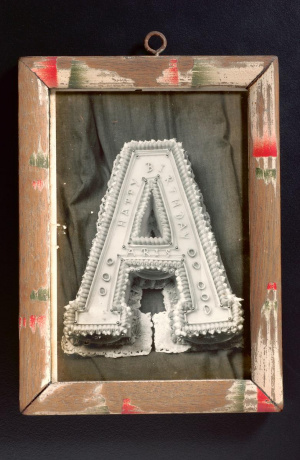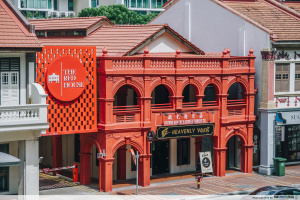Red House Katong (63 East Coast Road)

Located at 63 East Coast Road, The Red House is an iconic feature of Katong due to its distinctive fire-engine-red facade, which creates a striking contrast to the neighbouring white shophouses. While the renovation of the building was only completed in 2016 after 13 years of closure, the history of this heritage site dates back to the 1920s, when it housed a bakery and confectionery shop.[1]
Katong Bakery & Confectionary (1925 - 2003)
In the late 19th century and early 20th century, Katong was known as a quaint sea-side retreat where wealthy Singaporean families built their villas and bungalows.[2] The Red House was originally a private sea-front residence[3] before it was bought by a Jewish man named Jim Baker.[4] In 1925, Jim Baker re-purposed the house into the original Katong Bakery & Confectionary Company.[5]
Change of ownership
Between the 1920s to 1950s, Hainanese immigrants built a niche market of kopitiams, or coffee shops which then evolved into an indispensable part of Singapore’s culture.[6] In 1931 Tan Siang Fuan, a Hainanese seaman, took over Katong Bakery & Confectionery for a price of S$600.[7]
The Katong Bakery & Confectionary Company bakery was famous for its cream cakes, bread, curry puffs and swiss rolls,[8] and also served as a popular destination for local bands. According to Roots.sg, it was also the first bakery in Singapore to create a three-tiered wedding cake.[9] Similar to the other kopitiams during that time, the shop’s payment system was based on trust as patrons would only pay after finishing their food.[10] It was also the go-to place for parents who were planning to matchmake their children.[11]
The bakery was closed on 23 March 2003 as the shophouse was said to be structurally unsafe.[12] The historical site underwent a major facelift before reopening in 2016, with a new local coffee shop under its roof.
Wakaf land
In 1957, the shophouse that Katong Bakery & Confectionery was housed in was declared a wakaf asset along with 5 other neighbouring shophouses. The land, together with the shophouses, had been entrusted to the Islamic Religious Council of Singapore (MUIS) by Sheriffa Zain Mohamed Alsagoff, a philanthropist who had passed away in 1948.[13]
A wakaf property refers to a building or land that had been endowed or willed by a Muslim for future charitable uses.[14] Sheriffa belonged to the Alsagoff family who contributed greatly to early Singapore society. They even played a part in the construction of Raffles Hotel.[15] With her wakaf, Sheriffa aimed to use the rental income to fund her grandchildren’s education and to maintain a free pharmacy for the poor.[16]
Preservation and redevelopment
Following the closure of the Katong Bakery & Confectionery in 2003, the building had undergone a redevelopment project under Warees Investments, which is a real-estate development branch of MUIS.[17]
The 'Red House Project' was proposed as mixed-use development of 42 residential units, 5 shophouses and a local coffee house.[18] MUIS deliberately kept the iconic red facade of the building and sourced for a tenant that sells Halal baked goods and local delicacies similar to the Katong Bakery & Confectionery.[19] The Red House Project was completed in 2016.
As of December 2018, Heavenly Wang Cafe is the front-facing tenant of the property.[20] The cafe is furnished with retro floral tiles, old school furniture and traditional biscuit tins. In 2017, The Red House gained a special mention from the Urban Redevelopment Authority for its efforts in retaining a familiar social memory.[21]
References / Citations
- ↑ “Roll-out for Katong Bakery”. Asia One. June 23, 2013. Accessed on 28 March 2019. Retrieved from: https://www.asiaone.com/business/roll-out-katong-bakery
- ↑ “Katong, Joo Chiat Walking Map”. Urban Redevelopment Authority. Accessed on 28 March 2019. Retrieved from: https://www.ura.gov.sg/services/download_file.aspx?f=%7B4FD2B487-AB69-412A-B4A1-882EB442F1BB%7D
- ↑ “Katong, Joo Chiat Walking Map”. Urban Redevelopment Authority. Accessed on 28 March 2019. Retrieved from: https://www.ura.gov.sg/services/download_file.aspx?f=%7B4FD2B487-AB69-412A-B4A1-882EB442F1BB%7D
- ↑ Holmberg, J. “Heart of Katong”. The Straits Times. August 9, 1993. Retrieved from NewspaperSG.
- ↑ Holmberg, J. “Heart of Katong”. The Straits Times. August 9, 1993. Retrieved from NewspaperSG.
- ↑ Duruz, Jean. 2016. "The Taste of Retro: Nostalgia, Sesnsory Landscapes, and Cosmopolitanism in Singapore" in Food, Foodways And Foodscapes: Culture, Community And Consumption In Post-Colonial Singapore. Edited by Kong, Lily Lee Lee & Sinha, Vineeta. Singapore: World Scientific Publishing.
- ↑ Holmberg, J. “Heart of Katong”. The Straits Times. August 9, 1993. Retrieved from NewspaperSG.
- ↑ “Framed photograph of a birthday cake”. Roots. July 3, 2018. Accessed on 28 March 2019. Retrieved from: https://roots.sg/learn/collections/listing/1050805
- ↑ “Framed photograph of a birthday cake”. Roots. July 3, 2018. Accessed on 28 March 2019. Retrieved from: https://roots.sg/learn/collections/listing/1050805
- ↑ Lai Ah Eng. 2016. "The Kopitiam in Singapore: An Evolving Story about Cultural Diversity and Cultural Politics" in Food, Foodways And Foodscapes: Culture, Community And Consumption In Post-Colonial Singapore. Edited by Kong, Lily Lee Lee & Sinha, Vineeta. Singapore: World Scientific Publishing.
- ↑ Holmberg, J. “Heart of Katong”. The Straits Times. August 9, 1993. Retrieved from NewspaperSG.
- ↑ “The Red House at Katong”. Ghetto Singapore. July 20, 2017. Accessed on 28 March 2019. Retrieved from: http://www.ghettosingapore.com/the-red-house-at-katong/
- ↑ “Wakaf: Perpetual Giving”. Islamic Religious Council of Singapore. Accessed on 28 March 2019. Retrieved from: https://wakaf.sg/documents/WHT_brochure.pdf
- ↑ “Wakaf”. Islamic Religious Council of Singapore. March 26, 2019. Accessed on 28 March 2019. Retrieved from: https://www.muis.gov.sg/wakaf/About/What-is-Wakaf
- ↑ “The Red House at Katong”. Ghetto Singapore. July 20, 2017. Accessed on 28 March 2019. Retrieved from: http://www.ghettosingapore.com/the-red-house-at-katong/
- ↑ “Wakaf: Perpetual Giving”. Islamic Religious Council of Singapore. Accessed on 28 March 2019. Retrieved from: https://wakaf.sg/documents/WHT_brochure.pdf
- ↑ “Roll-out for Katong Bakery”. Asia One. June 23, 2013. Accessed on 28 March 2019. Retrieved from: https://www.asiaone.com/business/roll-out-katong-bakery
- ↑ Ang, Benson. “Restoring buildings to their former glory”. The Straits Times. November 1, 2017. Accessed on 28 March 2019. Retrieved from: https://www.tnp.sg/news/singapore/restoring-buildings-their-former-glory
- ↑ “The Red House at Katong”. Ghetto Singapore. July 20, 2017. Accessed on 28 March 2019. Retrieved from: http://www.ghettosingapore.com/the-red-house-at-katong/
- ↑ Ong, Isabelle. "9 Colourful Heritage Places In Joo Chiat And Katong - The Time Capsules Of The East". The Smart Local. December 28, 2018. Accessed on 23 April 2019. Retrieved from: https://thesmartlocal.com/read/joo-chiat-katong-instawalk
- ↑ Ang, Benson. “Restoring buildings to their former glory”. The Straits Times. November 1, 2017. Accessed on 28 March 2019. Retrieved from: https://www.tnp.sg/news/singapore/restoring-buildings-their-former-glory
